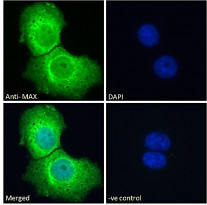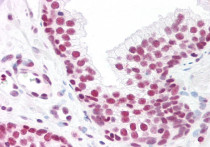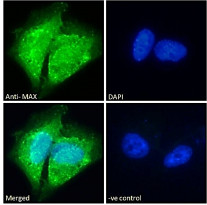ARG63125
anti-MAX antibody
anti-MAX antibody for ICC/IF,IHC-Formalin-fixed paraffin-embedded sections,Western blot and Human
Gene Regulation antibody
Overview
| Product Description | Goat Polyclonal antibody recognizes MAX |
|---|---|
| Tested Reactivity | Hu |
| Predict Reactivity | Ms, Rat, Cow, Dog |
| Tested Application | ICC/IF, IHC-P, WB |
| Specificity | This antibody is expected to recognize both reported isoforms (NP_002373.3; NP_660087.1). |
| Host | Goat |
| Clonality | Polyclonal |
| Isotype | IgG |
| Target Name | MAX |
| Antigen Species | Human |
| Immunogen | C-EEPQSRKKLRMEAS |
| Conjugation | Un-conjugated |
| Alternate Names | Protein max; Myc-associated factor X; bHLHd4; Class D basic helix-loop-helix protein 4 |
Application Instructions
| Application Suggestion |
|
||||||||
|---|---|---|---|---|---|---|---|---|---|
| Application Note | WB: Recommend incubate at RT for 1h. IHC-P: Antigen Retrieval: Steam tissue section in Citrate buffer (pH 6.0). * The dilutions indicate recommended starting dilutions and the optimal dilutions or concentrations should be determined by the scientist. |
Properties
| Form | Liquid |
|---|---|
| Purification | Purified from goat serum by antigen affinity chromatography. |
| Buffer | Tris saline (pH 7.3), 0.02% Sodium azide and 0.5% BSA. |
| Preservative | 0.02% Sodium azide |
| Stabilizer | 0.5% BSA |
| Concentration | 0.5 mg/ml |
| Storage Instruction | For continuous use, store undiluted antibody at 2-8°C for up to a week. For long-term storage, aliquot and store at -20°C or below. Storage in frost free freezers is not recommended. Avoid repeated freeze/thaw cycles. Suggest spin the vial prior to opening. The antibody solution should be gently mixed before use. |
| Note | For laboratory research only, not for drug, diagnostic or other use. |
Bioinformation
| Database Links | |
|---|---|
| Background | The protein encoded by this gene is a member of the basic helix-loop-helix leucine zipper (bHLHZ) family of transcription factors. It is able to form homodimers and heterodimers with other family members, which include Mad, Mxi1 and Myc. Myc is an oncoprotein implicated in cell proliferation, differentiation and apoptosis. The homodimers and heterodimers compete for a common DNA target site (the E box) and rearrangement among these dimer forms provides a complex system of transcriptional regulation. Multiple alternatively spliced transcript variants have been described for this gene but the full-length nature for some of them is unknown. [provided by RefSeq, Jul 2008] |
| Research Area | Gene Regulation antibody |
| Calculated MW | 18 kDa |
| PTM | Reversible lysine acetylation might regulate the nuclear-cytoplasmic shuttling of specific Max complexes. |
Images (5) Click the Picture to Zoom In
-
ARG63125 anti-MAX antibody WB image
Western Blot: Jurkat lysate (RIPA buffer, 1.4*10^5 cells per lane) stained with ARG63125 anti-MAX antibody at 0.1 µg/ml dilution.
-
ARG63125 anti-MAX antibody ICC/IF image
Immunofluorescence: Paraformaldehyde fixed A431 cells permeabilized with 0.15% Triton. Cells were stained with ARG63125 anti-MAX antibody (green) at 10 µg/ml dilution for 1 hour. DAPI (blue) for nuclear staining. Negative control: Unimmunized goat IgG (green) at 10 µg/ml dilution.
-
ARG63125 anti-MAX antibody IHC-P image
Immunohistochemistry: Paraffin-embedded Human prostate tissue. Antigen Retrieval: Steam tissue section in Citrate buffer (pH 6.0). The tissue section was stained with ARG63125 anti-MAX antibody at 10 µg/ml dilution followed by AP-staining.
-
ARG63125 anti-MAX antibody WB image
Western blot: 35 µg of Jurkat cell lysate (in RIPA buffer) stained with ARG63125 anti-MAX antibody at 0.01 µg/ml dilution and incubated at RT for 1 hour.
-
ARG63125 anti-MAX antibody ICC/IF image
Immunofluorescence: Paraformaldehyde fixed U251 cells permeabilized with 0.15% Triton. Cells were stained with ARG63125 anti-MAX antibody (green) at 10 µg/ml dilution for 1 hour. DAPI (blue) for nuclear staining. Negative control: Unimmunized goat IgG (green) at 10 µg/ml dilution.










